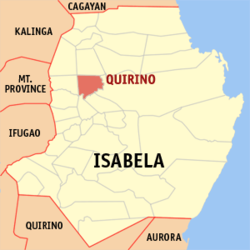Quirino (Isabela)
| Quirino | ||
|---|---|---|
| Municipio | ||
|
Localización de Quirino en Filipinas | ||
 | ||
| Coordenadas | 17°08′08″N 121°44′06″E / 17.135555555556, 121.735 | |
| Entidad | Municipio | |
| • País |
| |
| • Región | Valle del Cagayán | |
| • Provincia | Isabela | |
| Superficie | ||
| • Total | 126,2 km² | |
| Altitud | ||
| • Media | 50 m s. n. m. | |
| Población (2020) | ||
| • Total | 25 023 hab. | |
| • Densidad | 198,28 hab./km² | |
| Código postal | 3321[1] | |
| Prefijo telefónico | 78 | |
| Código ZIP | 023123[2] | |
| Sitio web oficial | ||
Quirino (Bayan ng Qurino) es un municipio filipino de cuarta categoría perteneciente a la provincia de La Isabela en la Región Administrativa de Valle del Cagayán, también denominada Región II.
Geografía
[editar]Tiene una extensión superficial de 126.20 km² y según el censo del 2007, contaba con una población de 21.192 habitantes y 4.178 hogares; 22.2854 habitantes el día primero de mayo de 2010[3]
Barangayes
[editar]Quirino se divide administrativamente en 21 barangayes o barrios, 20 de carácter rural y solamente uno, Santa Lucía, de carácter urbano.
|
|
Política
[editar]Su Alcalde (Mayor) es Jossie María Bella L. Juan.[4]
Historia
[editar]Municipio creado el 17 de junio de 1967 quedando formado su término por terrenos segregados de los municipios de Ilagan, Roxas de Isabela y Gamu:[5] De Ilagan proceden los barrios de Santa Lucía, San Mateo, Santo Domingo, Santiago, Manaoag, Vintar, Dolores y San José. De Roxas, el barrio y sitio de Camaal. De Gamu los barrios y sitios de Luna, Suerte, San Juan, Binarsang, Santa Catalina, Cabaruan y Sinait. La sede del gobierno del nuevo municipio será un sitio ubicado entre los barrios de Santa Lucía de Ilagan, y de la Luna de Gamu.
"...From the junction of the Mallig River and Cagayan River, running southwest along the center of Siffu River, towards Roxas until it reaches a point about 5.50 kilometers from the national highway (Calao- Enrile Road); running due north until it reaches the Mallig River; running eastward along the center of Mallig River until it reaches the existing boundary line of Ilagan, Mallig, and Magsaysay; following the existing boundary line of Mallig and Ilagan, and the boundary line of Magsaysay and Tumauini up to the point of beginning..."REPUBLIC ACT NO. 4901
Referencias
[editar]- ↑ Worldpostalcodes.org, código postal n.º 3321.
- ↑ Region Philippine Standard Geographic Codes as of 30 September 2012. Archivado el 14 de noviembre de 2012 en Wayback Machine.
- ↑ 2010 Census of Population and Housing.
- ↑ «Republic of the Philippines Department of the Interior and Local Governement Kagawaran ng Interyor at Pamahalaang Lokal.». Archivado desde el original el 15 de mayo de 2012. Consultado el 11 de abril de 2013.
- ↑ «REPUBLIC ACT NO. 4901 AN ACT CREATING THE MUNICIPALITY OF QUIRINO IN THE PROVINCE OF ISABELA.». Archivado desde el original el 29 de octubre de 2013. Consultado el 25 de octubre de 2013.
